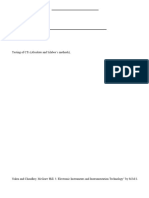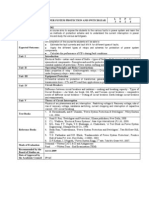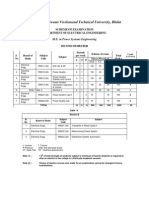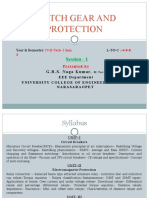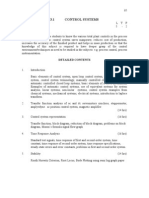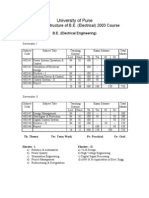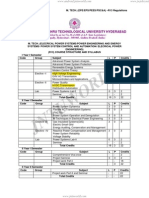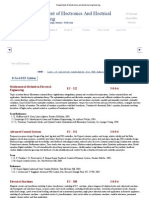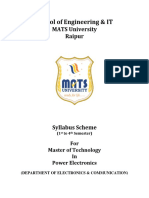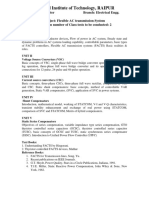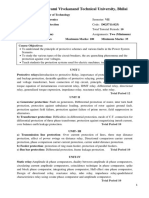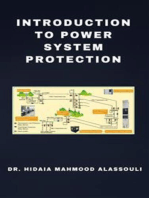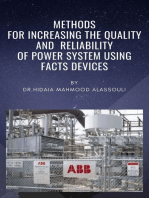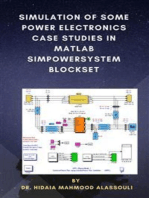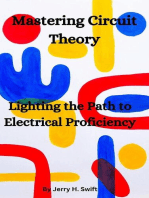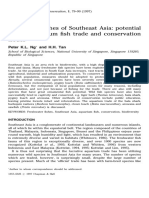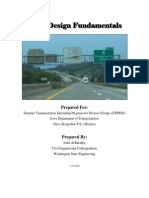M Tech EEE Ist Sem - Syllabus
M Tech EEE Ist Sem - Syllabus
Uploaded by
Abhishek GahirwarCopyright:
Available Formats
M Tech EEE Ist Sem - Syllabus
M Tech EEE Ist Sem - Syllabus
Uploaded by
Abhishek GahirwarOriginal Description:
Original Title
Copyright
Available Formats
Share this document
Did you find this document useful?
Is this content inappropriate?
Copyright:
Available Formats
M Tech EEE Ist Sem - Syllabus
M Tech EEE Ist Sem - Syllabus
Uploaded by
Abhishek GahirwarCopyright:
Available Formats
Chhattisgarh Swami Vivekanand Technical University Bhilai (C.G.
)
SCHEME OF EXAMINATION
DEPARTMENT OF ELECTRICAL & ELECTRONICS ENGINEERING
M.Tech. in Electrical Devices & Power System Engineering
FIRST SEMESTER
S.
NO.
Board of Study
Subject
Code
Subject
High Voltage Engineering
Electrical and
Electronics
Engg.
570111(25)
Electrical Engg.
559113(24)
Electrical Engg.
559114(24)
Electrical and
Electronics
Engg.
570112(25)
Refer Table-I
Period
per Week
Scheme of exam
Theory/Practical
Total
Marks
Credit
L+(T+P)/2
ESE
CT
TA
100
20
20
140
100
20
20
140
100
20
20
140
Industrial Drive and
Control
100
20
20
140
Elective-I
100
20
20
140
Power System
Protection
Flexible AC Transmission
System (FACTS)
Electrical Engg.
570121(24)
Power System Protection
Lab.
75
75
150
Electrical and
Electronics
Engg.
570122(25)
High Voltage Lab.
75
75
150
15
650
100
250
1000
24
Total
Table 1
Elective- I
S.
No.
Board of Study
Subject Code
Subject
Electrical and Electronics Engg.
570131 (25)
Energy System
Electrical Engg.
559111(24)
Power System Dynamics
Electrical and Electronics Engg.
570132 (25)
Advanced Engineering Mathematics
Lecture T- Tutorial P- Practical ESE- End Semester Exam
CT- Class Test TA- Teachers Assessment
Note (1) 1/4th of total strength of students subject to minimum of eighteen students is required to
offer an
elective in the college in a Particular academic session .
Note (2) Choice of elective course once made for an examination cannot be changed in future
Chhattisgarh Swami Vivekanand Technical University Bhilai (C.G.)
Semester: M.TECH. 1st
Subject: High Voltage Engg.
Total Theory Periods: 40
Total Marks in End Semester Exam. : 100
Minimum number of class test to be conducted: 02
Specialization: Electrical Devices and Power System Engg.
Branch: Electrical and Electronics Engineering
Code: 570111(25)
Total Tutorial Periods: 12
UNIT-I
Generation of High Voltages:
Direct Voltage: AC to DC converter, Electrostatic Generators; Alternating Voltage: Testing
Transformer, Series Resonant Circuit; Impulse Voltage: Impulse voltage generator circuits, Design,
construction and operation of generator and control system.
UNIT-II
Measurement of High Voltages: Introduction to Sphere gap, Rod gap and uniform field gap; The
Chubb-Fortes cue method, Voltage divider and passive rectifier circuits, Active peak reading circuit,
High voltage capacitor measuring circuits, Voltage divider system and measurement of impulse
voltage, Fast digital transient recorder for impulse voltage measurement
UNIT-III
Electrostatic field and field stress control: Electrical field distribution and breakdown strength of
insulating materials, Fields in homogeneous and multi dielectric isotopic materials, Numerical
methods.
UNIT-IV
Breakdown in Gases: Classical gas laws, Ionization and decay process, Cathode process- secondary
effects, The Townsend mechanism, Streamer mechanism of spark, Paschens law, penning effect,
Breakdown field strength, Breakdown in non-uniform field, Effect of electron attachment on
breakdown criteria, Influence of space charge-Polarity effect, Surge breakdown voltage-time lag and
Corona.
UNIT-V
Breakdown in Solid & Liquid dielectrics: Intrinsic, Streamer, electromechanical, thermal and
erosion breakdown of solid dielectrics; Treeing and Tracking in solid insulating materials, Electronic
and suspended solid particle breakdown mechanism, cavity breakdown, Electro convection and
electro hydrodynamic model of dielectrics, Static electrification in Power Transformer.
Text Books:
1. Conduction and Breakdown in Mineral Oils By A.A. Zaky and R. Hawley.. Pergamon Press,
Oxford, 1973.
2. Simple Dielectric Liquids by T.J. Gallagher. Clarendon Press, Oxford, 1975.
3. Dielectric Relaxation in Solids. By A.K. Jonscher,. Chelsea Dielectrics Press, London, 1983.
4. Electronic Processes in Non-crystalline Materials. N.F Mott and E.A. Davies Oxford University
Press 1979.
5. High Voltage Measurement Techniques A.J. Schwab. M.I.T Press, 1972.
Reference books:
6. Technology of Electrical Measurements. See Chapter 4 in L. Schnell (ed.).. John Wiley and Sons
Ltd, 1993,
7. Alternating-Current Bridge Methods (5th ed). By B. Hague Pitman & Sons, London, 1962.
Chhattisgarh Swami Vivekanand Technical University Bhilai (C.G.)
Semester: M.TECH. 1st
Subject: Power System Protection
Total Theory Periods: 40
Total Marks in End Semester Exam. : 100
Minimum number of class test to be conducted:
Specialization: Electrical Devices and Power System Engg.
Branch: Electrical and Electronics Engineering
Code: 559113 (24)
Total Tutorial Periods: 12
Unit 1
Protective Relaying - Qualities of relaying, Definitions, Codes, Standards, Characteristic Functions,
Classification, analog-digital - numerical, schemes and design, factors affecting performance, zones and
degree of protection, faults types and evaluation, Instrument transformers for protection.
Unit 2
Basic static relay units, sequence networks, fault sensing data processing units, FFT and Wavelet based
algorithms, Phase& Amplitude Comparators, Duality, Zero Crossing/Level Defectors,
Relay Schematics and An alysis, Over Current Relay, Instantaneous/Inverse Time IDMT Characteristics;
Directional Relays; Differential Relays, Restraining Characteristics; Distance Relays:
Types,
Characteristics;
Unit 3
Protection of Power System Equipment, Generato r, Transformer, Generator, Transformer Units,
Transmission Systems, Bus-bars, Motors; Pilot wire and Carrier Current Schemes;
System grounding, ground faults and protection, Load shedding and frequency relaying, Out of step
relaying, Re-closing and synchronizing.
Unit 4
Numerical relays, Characteristics, Functional Diagrams, architecture, algorithms, Microprocessor & DSP
based relays, sampling, aliasing, filter principles,
Integrated and multifunction protection schemes, SCADA based protection systems, FTA, Testing of
Relays.
Unit 5
AC Circuit Breakers : Current interruption, Transient Recovery Voltage (TRV) , Rate of rise of TRV,
Resistance switching, Damping of TRV, Opening Resistors, Inductive & Capacitive current interruptions
, Current chopping , Rated characteristics of Circuit breakers, Types of Circuit Breakers, Testing of
High Voltage AC Circuit Breakers
Text Books:1 C.R. Mason, The art and science of protective relaying, John Wiley & Sons.
2 A.R.Warrington, Protective Relays, Vol .1&2, Chapman and Hall.
REFERENCES:
1. T.S.Madhav Rao, Power system protection static relays with microprocessor applications, Tata McGraw
Hill Publication.
2. Power System Protection Vol. I, II , III&IV, The Institution Of Electrical Engineers, Electricity Association
Services Ltd., 1995
3. Helmut Ungrad , Wilibald Winkler, Andrzej Wiszniewski, Protection techniques in electrical
energy systems, Marcel Dekker, Inc.
4. Badri Ram , D.N. Vishwakarma, Power system protection and switch gear, Tata McGraw H ill.
5. Blackburn, J. Lewis ,Protective Relaying, Principles and Applications , Marcel Dekker, Inc., 1986.
6. Anderson, P.M, Power System Protection,. McGraw-Hill, 1999
7. Singh L.P ,Digital Protection, Protective Relaying from Electromechanical to Mic roprocessor, John
Wiley
& Sons, 1994
8. Wright, A. and Christopoulos, C, Electrical Power System Protection,. Chapman & Hall, 1993,
Chhattisgarh Swami Vivekanand Technical University Bhilai (C.G.)
Semester: M.Tech. 1st
Subject: Flexible AC transmission System (FACTS)
Total Theory Periods: 40
Total Marks in End Semester Exam. : 100
Minimum number of class test to be conducted: 02
Specialization: Electrical Devices and Power System Engg..
Branch: Electrical Engineering
Code: 559114 (24)
Total Tutorial Periods: 12
Unit I
FACTS Concept and General System Considerations, Power Flow in AC System, Definitions on FACTS,
Basic Types of FACTS Controllers.
Converters for Static Compensation, Three Phase Converters and Standard Modulation Strategies
(Programmed Harmonic Elimination and SPWM), GTO Inverters, Multi -Pulse Converters and Interface
Magnetics,
Unit II
Transformer Connections for 12 , 24 and 48 pulse operation, Multi -Level Inverters of Diode Clamped
Type and Flying Capacitor Type and suitable modulation strategies (includes SVM), Multi -level
inverters of Cascade Type and their modulation, Current Control of Inverters
Unit III
Static Shunt Compensators, SVC and STATCOM, Operation and Control of TSC, TCR, STATCOM,
Compensator Control, Comparison between SVC and STATCOM, STATCOM for transient and dynamic
stability en hancement
Unit IV
Static Series Compensation, GCSC, TSSC, TCSC and SSSC, Operation and Control, External System
Control for Series Compensators, SSR and its damping, Static Voltage and Phase Angle Regulators, TCVR
and TCPAR, Operation and Control
Unit V
UPFC and IPFC, The Unified Power Flow Controller, Operation, Comparison with other FACTS devices,
control of P and Q, Dynamic Performance, Special Purpose FACTS Controllers, Interline Power Flow
Controller, Operation and Control.
Text Books:
1. N.G . Hingorani & L. Gyugyi : Understanding FACTS: Concepts and Technology of Flexible AC
Transmission Systems. IEEE Press, 2000.
2. T.J.E Miller, Reactive Power Control in Electric Systems John Wiley & Sons
REFERENCES:
1. Ned Mohan et.al: Power Electronics.John Wiley and Sons.
2. FACTS Controllers and applications course book for STTP, 2003, Dr Ashok S & K S Suresh kumar
Chhattisgarh Swami Vivekanand Technical University Bhilai (C.G.)
Semester: M.TECH. 1st
Subject: Industrial Drives and Control
Total Theory Periods: 40
Total Marks in End Semester Exam. : 100
Minimum number of class test to be conducted: 02
Specialization: Electrical Devices and Power System Engg.
Branch: Electrical and Electronics Engineering
Code: 570112 (25)
Total Tutorial Periods: 12
UNIT I
Introduction: Review of solid state devices, switch characteristics and their comparison, semi-conductor
materials.
UNIT II
Industrial Electronic Devices Phase controllers, Dual converters, Choppers, Cyclo-converters, Inverters, Power
Supplies, Multivibrators, Switching Transistors and Timers.
UNIT III
Design of Industrial Electronic Devices Design and analysis of electromagnetic control of electric drives, their
characteristics, operating modes, Motor Control, Heating and Welding Control, Opto-electronics and Optical
Fibers, Servomotors and their applications. Resonant converters; Modeling strategies. Analysis and design of
Power Electronics Circuit.
UNIT IV
Industrial application of Industrial Electronic Devices Control of electric drives used in manufacturing and
process industries, protection of electric drives using solid state devices and controllers, analysis of drive
systems. Stepper motor and Drive configurations. Brush less DC drive configuration. Low speed commutation.
Inverter control strategies.
UNIT V
Testing for drive controllers Design and testing of microprocessor based drive controllers, analysis of solid state
control of industrial drives, design and testing of thyristor based controllers for electric drives
TEXT BOOKS:
1.
2.
3.
Dubey G.K., Power Semiconductor Controlled Drive, Prentice Hall, New Jersey
Sen P.C., Thyristor Controlled DC Drives, Wiley, New York
Murphy J.M.D. and Turnbull F.G., Power Electronics Control of AC Motors, Franklin Book Co.
REFERENCE BOOKS:
4.
5.
Bose B.K., Power Electronics and AC Drives, Prentice Hall, New Jersey
Bose B.K., Power Electronics and Variable Frequency Drives-Technology and applications, IEEE Pres
Chhattisgarh Swami Vivekanand Technical University Bhilai (C.G.)
Semester: M.TECH. 1st
Subject: Energy System
Total Theory Periods: 40
Total Marks in End Semester Exam. : 100
Minimum number of class test to be conducted: 02
Specialization: Electrical Devices and Power System Engg.
Branch: Electrical and Electronics Engineering
Code: 570131 (25)
Total Tutorial Periods: 12
UNIT-I
Energy and Environment
Fundamental Concepts of Energy: Laws of thermodynamics as applied to energy transfer and
transformations: Heat transfer and insulation.
UNIT-II
Energy Sources: Conventional - Fossil fuel, hydro-power and nuclear power, non conventional - solar,
wind, hydel, geothermal, tidal, biomass.
UNIT-III
Energy Convention Systems: Environmental aspects of energy conversion systems, thermal power
plants- fuel processing, process of combustion, thermal and air pollution aspects, problems of fly-ash,
hydro-electric power plants (including mini and micro power plants) location, impacts on land,
water and ecological resources, nuclear power plants environmental consequences of nuclear fuel
handling, power generation and waste disposal.
UNIT-IV
Energy Audit: Types and recommended practices
Energy Management - Problems & Prospects: Energy management strategies both at generation and
demand ends, alternate sources of energy; need for appropriate technologies, energy demand patterns
and strategies for energy conversation, energy management in industrial sector and its effect on
environment.
UNIT-V
Non-conventional energy resources; Solar, geothermal, wind, hydrogen, nuclear energy.
TEXT BOOKS:
1. Rau JG and Wooten DC, Environmental Impact Assessment, McGraw Hill, New Delhi
2. R.E. Munn, Environmental Impact Assessment, John Wiley and Sons, New York, USA
REFERENCE BOOKS:
1. J.M. Smith, H.C., Van Ness, Introduction to Chemical Engineering Thermodynamics, McGraw Hill,
New York, USA
Chhattisgarh Swami Vivekanand Technical University Bhilai (C.G.)
Semester: M.Tech. 1st
Subject: Power System Dynamics
Total Theory Periods: 40
Total Marks in End Semester Exam. : 100
Minimum number of class test to be conducted: 02
Specialization: Electrical Devices and Power System Engg..
Branch: Electrical Engineering
Code: 559111 (24)
Total Tutorial Periods: 12
UNIT-1
Elementary Mathematical Model: Swing Equation , Units , Mechanical Torque , Electrical Torque ,
Power - Angle Curve of a Synchronous Machine , Natural Frequencies of Oscillation of a Synchronous
Machine , System of One Machine against an Infinite Bus- The Classical Model , Equal Area Criterion ,
Classical Model of a Multimachine System, Classical Sta bility Study of a Nine-Bus System,
Shortcomings of the Classical Model, Block Diagram of One Machine.
UNIT-2
Synchronous Machine: Parks Transformation , Flux Linkage Equations , Voltage Equations ,
Formulation of State - Space Equations , Current Formula tion , Per Unit Conversion , Normalizing the
Voltage Equations, Normalizing the Torque Equations , Torque and Power , Equivalent Circuit of a
Synchronous Machine , The Flux Linkage State -Space Model , Loaf Equations , Sub transient and
Transient Inductances and Time Constants , Turbine Generator Dynamic Models
UNIT-3
Simulation of Synchronous Machine: Steady-State Equations and Phasor Diagrams, Machine
Connected to an Infinite Bus through a Transmission Line, Machine Connected to an Infinite Bus with
Local Load at Machine Terminal, Determining Steady- State Conditions, Initial Conditions for a
Multimachine System , Determination of Machine Parameters from Manufacturers Data , Analog
Computer Simulation of the Synchronous Machine, Digital Simulation of Syn chronous Machines.
Linear Model of Synchronous Machine: Linearization of the Generator State -Space Current
Model,
Linearization of the Load Equation for the One- Machine Problem, Linearization of the Flux Linkage
Model, Simplified Linear Model, Block Diagrams, State-Space Representation of Simplified Model.
UNIT-4
Excitation Systems: Simplified View of Excitation Control, Control Configurations, Typical
Excitation Configurations, Excitation Control System Definitions, Voltage Regulator, Exciter Buildup,
Excitation System response, State Space Description of the Excitation System, State Space
Representation of the Excitation system, Computer Representation of Excitation Systems, Typical
Systems Constants, The effect of Excitation on Generator Performance.
Effect of Excitation on Stability: Effect of Excitation on Generator Power limits, Effect of the
Excitation System on Transient Stability, Effect of Excitation on Dynamic Stability, Root Locus
Analysis of a Regulated Machine Connected to an Infinite Bus , Approximate System Representation,
Supplementary Stabilizing Signals, Liner Analysis of the Stabilized Generator. General Comments on
the Effect of Excitation on Stability.
UNIT-5
Multimachine Systems with Constant Impedance Load: Statement of the Problem, Matrix
representation
of a Passive Network, Converting Machine Coordinates to System Reference, Relation Between
Machine Currents & Voltages, System Order, Machines Represented by Classical Methods, Linearized
Model for the Network, Hybrid Formulation, Network Equation with Flux Linkage Model, Total
System Equation, Multimachine System Study.
Text Books:
1. Power System Control and Stability Vol -I By P. M. Anderson & A. A. Fouad.
2. Power System Stability and Control by Prabha Kundur - EPRI. Mc Graw Hill Inc.
Reference Books:
1. Power System Dynamic Stability and Control, Padiyar Interline Publisher Bangalore
Chhattisgarh Swami Vivekanand Technical University Bhilai (C.G.)
Semester: M.TECH. 1st
Subject: Advanced Engineering Mathematics
Total Theory Periods: 40
Total Marks in End Semester Exam. : 100
Minimum number of class test to be conducted: 02
Specialization: Electrical Devices and Power System Engg..
Branch: Electrical and Electronics Engineering
Code: 570132 (25)
Total Tutorial Periods: 12
UNIT - I CALCULUS OF VARIATION
Functional Eulers equation Variational problems involving one unknown function Several
unknown functions Functionals dependent on higher order derivatives Several independent
variables Isoperimetric problems.
UNIT - II
Z TRANSFORM
Transform of standard functions Convolution Initial and Final value problems Shifting
Theorem Inverse transform (Using Partial Fraction Residues) Solution of difference Equations
using Z Transform.
UNIT - III SINGLE OBJECTIVE OPTIMIZATION ALGORITHM
Optimal problem formulation: Constraints, objective functions, variable bounds. Single
variable optimization algorithm: optimality criteria bracketing method; exhaustive search
method & bounding phase method. Region elimination methods interval halving method,
Fibonnaci search method Root finding using optimization technique.
UNIT IV MULTI OBJECTIVE OPTIMIZATION PROBLEMS
Basic concepts non-dominated solutions preference structures, basic solution
approach Weighted sum approach; Random weight approach, Adaptive weight approach.
Distance method, concepts calculation of distance measure applications.
Compromise approach and goal programming approach.
UNIT - V
CONSTRAINED OPTIMIZATION ALGORITHM
Khun Tucker conditions transformation methods; penalty function method and multiplier
method sensitivity analysis direct search for constrained minimization; variable elimination
method, complex search method, random search method Generalized reduced gradient
method gradient projection method.
TEXT BOOKS:
1.
S. S. Rao, Optimization Theory and Applications, Wiley Eastern Limited, Second
Edition, 1984.
REFERENCE BOOKS:
2.
Kalyanmoy Deb, Optimization for Engineering Design Algorithms and Examples,
Prentice Hall India, Fifth printing, 2002
Chhattisgarh Swami Vivekanand Technical University Bhilai (C.G.)
Semester: M.Tech. 1st
Subject: Power System Protection
Total Practical Periods: 40
Total Marks in End Semester Exam. : 75
Specialization: Electrical Devices and Power System Engg..
Branch: Electrical Engineering
Code: 559121 (24)
List of Experiments:
Ratio Test of a C.T and determination of error.
Determination of knee point voltage of a CT.
3 Summation Transformer characteristics.
Study of CT Connection for E/F protection.
Study of Open delta PT Connection for earth fault indication.
Protection of 3 ph. Alternater (simulation study).
Protection of 3 ph. Induction Motor (simulation study).
Over current / under voltage / Negative seq Relay Characteristics (simulation
study).
Simulation of Transmission line protection.
Study of differential protection of transformer (simulation study).
Chhattisgarh Swami Vivekanand Technical University Bhilai (C.G.)
Semester: M.TECH. 1st
Subject: High Voltage Lab
Total Theory Periods: 40
Total Marks in End Semester Exam. : 75
Specialization: Electrical Devices and Power System Engg..
Branch: Electrical and Electronics Engineering
Code: 570122 (25)
List of Experiments:
1.
High voltage AC measurement.
2.
High voltage DC measurement.
3.
High Impulse voltage measurement.
4.
5.
Study of break down phenomena in air, oil and solid dielectrics under uniform and non-uniform
electrode configurations.
Capacitance and loss tangent measurement.
6.
Partial discharge measurement.
7.
Measurement of Earth resistance.
8.
Measurement of resonant frequencies and internal voltage distribution in transformer windings.
9.
Electromagnetic field measurement using field meter.
10. Measurement of harmonics using Energy analyzer.
You might also like
- Column Designs Calculation Excel FileDocument45 pagesColumn Designs Calculation Excel FileFarukNo ratings yet
- M Tech EEE IInd Sem - SyllabusDocument10 pagesM Tech EEE IInd Sem - SyllabusAbhishek GahirwarNo ratings yet
- 6th Sem ElectricalDocument15 pages6th Sem Electricalaki007guptaNo ratings yet
- 4 SYALLABUS B.TEX-VI-semDocument8 pages4 SYALLABUS B.TEX-VI-semHARSHNo ratings yet
- Department of Electrical Engineering: Ea6210: Switchgear and ProtectionDocument5 pagesDepartment of Electrical Engineering: Ea6210: Switchgear and ProtectionAvi PokiNo ratings yet
- Switch GearDocument2 pagesSwitch GearSiddhartha Chowdhary GNo ratings yet
- ME Power System SyllubusDocument6 pagesME Power System Syllubusprachi_shrivasNo ratings yet
- 2 Sem ME Elect PowerDocument10 pages2 Sem ME Elect PowerAkash YadavNo ratings yet
- Switch Gear and Protection: Session - 1Document20 pagesSwitch Gear and Protection: Session - 1Ravi Era StartsNo ratings yet
- Sem6 SyllabusDocument5 pagesSem6 SyllabusSamsung TabletNo ratings yet
- Electrical 5th SemesterDocument13 pagesElectrical 5th SemesterAbhishek JainNo ratings yet
- Shivaji University, Kolhapur: T.E. (Electrical Engineering) (Semester - VI)Document15 pagesShivaji University, Kolhapur: T.E. (Electrical Engineering) (Semester - VI)sudhirdhadge39No ratings yet
- M.tech 2ND Sem SyllabusDocument6 pagesM.tech 2ND Sem SyllabusraghuNo ratings yet
- II Power System (SY) 060511014443 PDFDocument5 pagesII Power System (SY) 060511014443 PDFvims1240% (1)
- 3.1 Control Systems: RationaleDocument15 pages3.1 Control Systems: RationaleSoumya BhattacharyaNo ratings yet
- BE Electrical Engineering Syllabus Final Draft As On 13 FebDocument37 pagesBE Electrical Engineering Syllabus Final Draft As On 13 Febviren72No ratings yet
- Class NotesDocument57 pagesClass NotesNisar AhmedNo ratings yet
- Power System Control and AutomationDocument23 pagesPower System Control and AutomationOM NamashivayaNo ratings yet
- Protection and SwitchgearDocument39 pagesProtection and Switchgearsyed1188100% (4)
- Elecrical Power SystemsDocument23 pagesElecrical Power SystemsVishwanathSrinivasNo ratings yet
- II Power System (SY) 060511014443Document5 pagesII Power System (SY) 060511014443Ankur TamrakarNo ratings yet
- Power System Control and Automation SyllabusDocument23 pagesPower System Control and Automation SyllabusSrikanth Mutyala100% (1)
- High Voltage Engg r13 Mtech PDFDocument24 pagesHigh Voltage Engg r13 Mtech PDFSal ExcelNo ratings yet
- 7th Sem EEEDocument17 pages7th Sem EEEGold KnowinNo ratings yet
- IES Books& SyllabusDocument4 pagesIES Books& SyllabusRajesh KumarNo ratings yet
- JNTUH Syllabus 2013 M.Tech EPSDocument23 pagesJNTUH Syllabus 2013 M.Tech EPSSRINIVASA RAO GANTANo ratings yet
- Department of Electronics and Electrical EngineeringDocument3 pagesDepartment of Electronics and Electrical EngineeringbasabNo ratings yet
- Electrical Electronics Engineering: Sssutms SehoreDocument16 pagesElectrical Electronics Engineering: Sssutms SehoreolexNo ratings yet
- Detailed Syllabus FOR 5 Semester: Anpat Niversity U. V. Patel College of Engineering Ganpat Vidyanagar, Kherva-382711Document10 pagesDetailed Syllabus FOR 5 Semester: Anpat Niversity U. V. Patel College of Engineering Ganpat Vidyanagar, Kherva-382711Maulik SharmaNo ratings yet
- EE2 E23 A 1Document4 pagesEE2 E23 A 1chandankumarznetNo ratings yet
- B.SC (MS) 2013 Sem IIIDocument18 pagesB.SC (MS) 2013 Sem IIIRahi razaNo ratings yet
- JFTTRHGHMJBDocument21 pagesJFTTRHGHMJBBikash Ranjan DashNo ratings yet
- ECE 131 Lecture 0Document15 pagesECE 131 Lecture 0Uttkarsh KumarNo ratings yet
- Module-2 Papers 1Document4 pagesModule-2 Papers 1vi2viNo ratings yet
- Power SystemDocument22 pagesPower SystemVenkat RamanNo ratings yet
- Syllabus - IInd Sem Power ElectronicsDocument9 pagesSyllabus - IInd Sem Power ElectronicsUmashankar VermaNo ratings yet
- em Theory:: Paper IDocument3 pagesem Theory:: Paper IDeepthi Madhav AnnavarapuNo ratings yet
- M.tech SyllabusDocument36 pagesM.tech SyllabusprateekiitkNo ratings yet
- Elecrical Power SystemsDocument23 pagesElecrical Power SystemssrichanderNo ratings yet
- Electri Sem 8Document4 pagesElectri Sem 8Ajeet KumarNo ratings yet
- Chhattisgarh Swami Vivekananda Technical University, Bhilai Scheme of Teaching and Examination Be (Electrical Engineering) Iv SemesterDocument12 pagesChhattisgarh Swami Vivekananda Technical University, Bhilai Scheme of Teaching and Examination Be (Electrical Engineering) Iv SemesterAnonymous l5X3VhTNo ratings yet
- Syllabus - B Tech 7th Semester For WebsiteDocument20 pagesSyllabus - B Tech 7th Semester For WebsiteSurya ElectronicsNo ratings yet
- Switchgear & Protection PDFDocument3 pagesSwitchgear & Protection PDFrameshNo ratings yet
- Power Systems Electromagnetic Transients Simulation 2nd Edition Neville Watson download pdfDocument55 pagesPower Systems Electromagnetic Transients Simulation 2nd Edition Neville Watson download pdfculmoboera0g100% (1)
- 2 FullDocument8 pages2 FullDhaval MerNo ratings yet
- ELECTENG 731 Lecture 1 2015 NirmalDocument39 pagesELECTENG 731 Lecture 1 2015 NirmalJohn SmithNo ratings yet
- Ne01 Scto Electrical / Electronics & TelecommunicationDocument4 pagesNe01 Scto Electrical / Electronics & TelecommunicationvivekNo ratings yet
- KTH EI2436 20142 1 enDocument2 pagesKTH EI2436 20142 1 enGIngaaNo ratings yet
- Introduction to Power System ProtectionFrom EverandIntroduction to Power System ProtectionRating: 5 out of 5 stars5/5 (1)
- Protection of Substation Critical Equipment Against Intentional Electromagnetic ThreatsFrom EverandProtection of Substation Critical Equipment Against Intentional Electromagnetic ThreatsNo ratings yet
- Distribution of Electrical Power: Lecture Notes of Distribution of Electric Power CourseFrom EverandDistribution of Electrical Power: Lecture Notes of Distribution of Electric Power CourseNo ratings yet
- Methods for Increasing the Quality and Reliability of Power System Using FACTS DevicesFrom EverandMethods for Increasing the Quality and Reliability of Power System Using FACTS DevicesNo ratings yet
- Simulation of Some Power Electronics Case Studies in Matlab Simpowersystem BlocksetFrom EverandSimulation of Some Power Electronics Case Studies in Matlab Simpowersystem BlocksetNo ratings yet
- Simulation of Some Power Electronics Case Studies in Matlab Simpowersystem BlocksetFrom EverandSimulation of Some Power Electronics Case Studies in Matlab Simpowersystem BlocksetNo ratings yet
- Simulation of Some Power System, Control System and Power Electronics Case Studies Using Matlab and PowerWorld SimulatorFrom EverandSimulation of Some Power System, Control System and Power Electronics Case Studies Using Matlab and PowerWorld SimulatorNo ratings yet
- Power Electronics and Energy Conversion Systems, Fundamentals and Hard-switching ConvertersFrom EverandPower Electronics and Energy Conversion Systems, Fundamentals and Hard-switching ConvertersNo ratings yet
- V2i6201358 PDFDocument9 pagesV2i6201358 PDFAbhishek GahirwarNo ratings yet
- Torkzadeh2014 PDFDocument7 pagesTorkzadeh2014 PDFAbhishek GahirwarNo ratings yet
- CGPSC Prelims Gs Paper 2 2014Document8 pagesCGPSC Prelims Gs Paper 2 2014Abhishek GahirwarNo ratings yet
- Iz'u I @ Iz'u I @ Iz'u I @ Iz'u I @: Exam - Cgm-12Document8 pagesIz'u I @ Iz'u I @ Iz'u I @ Iz'u I @: Exam - Cgm-12Abhishek GahirwarNo ratings yet
- Energy Managment and Audit PDFDocument189 pagesEnergy Managment and Audit PDFAbhishek GahirwarNo ratings yet
- Educational Philosophies-Comparison Chart With TraditionalDocument1 pageEducational Philosophies-Comparison Chart With Traditionalhira muneerNo ratings yet
- Bus-Bar ProtectionDocument22 pagesBus-Bar Protectionrakesh100% (2)
- Case Study On E-Supply ChainsDocument14 pagesCase Study On E-Supply ChainsTabeer HashmiNo ratings yet
- Using Sequences of Life-Events To Predict Human Lives: Nature Computational ScienceDocument17 pagesUsing Sequences of Life-Events To Predict Human Lives: Nature Computational SciencechizhikchiNo ratings yet
- Newtons Laws of MotionDocument17 pagesNewtons Laws of MotionlouserafaelNo ratings yet
- Hats A Thesis StatementDocument8 pagesHats A Thesis StatementBuyAPaperOnlineUK100% (2)
- Sample - Cover - Letter - HSG - CV CV CVDocument1 pageSample - Cover - Letter - HSG - CV CV CVSamirov BENABDERRAHMANENo ratings yet
- Sds Navigo Tpeo Highbn en GB UDocument8 pagesSds Navigo Tpeo Highbn en GB Uvictor victorNo ratings yet
- The Four Doors A Guide To Joy, Freedom, and A Meaningful Life by Richard Paul Evans - Special Preview Excerpt!Document22 pagesThe Four Doors A Guide To Joy, Freedom, and A Meaningful Life by Richard Paul Evans - Special Preview Excerpt!Simon and Schuster100% (1)
- TÜV莱茵化学测试与分析Document12 pagesTÜV莱茵化学测试与分析Snowy WondersNo ratings yet
- Sae J 2045 2012-11-01Document16 pagesSae J 2045 2012-11-01GT-LUCAS BARCI100% (2)
- Journal of Family TherapyDocument24 pagesJournal of Family TherapyGhanjati SondesNo ratings yet
- Chapter 2B Methods of Analysis (DC Circuits)Document24 pagesChapter 2B Methods of Analysis (DC Circuits)Khóa Học MS Word Miễn PhíNo ratings yet
- Geriatri at GlanceDocument29 pagesGeriatri at GlanceHarli RaivonNo ratings yet
- English Grade 1 Part 1 (Pupil's Book)Document152 pagesEnglish Grade 1 Part 1 (Pupil's Book)Vladimir Oscar Osorio CornejoNo ratings yet
- Fourth SemesterDocument18 pagesFourth SemesterGopinath NarayananNo ratings yet
- Measuring Vulnerability To Promote Disaster-Resilient Societies: Conceptual Frameworks and DefinitionsDocument46 pagesMeasuring Vulnerability To Promote Disaster-Resilient Societies: Conceptual Frameworks and DefinitionsMoldovan Petre100% (2)
- 6305-Article Text-12367-1-10-20210204Document10 pages6305-Article Text-12367-1-10-20210204Kenneth CabezasNo ratings yet
- 1997 Freshwater Fishes of Southeast Asia. Potential For The Aquarium Fish Trade and Conservation IssuesDocument12 pages1997 Freshwater Fishes of Southeast Asia. Potential For The Aquarium Fish Trade and Conservation IssuesAzham YahyaNo ratings yet
- Lessons 1-2: Analyzing The Structure and Language of Academic and Professional TextsDocument22 pagesLessons 1-2: Analyzing The Structure and Language of Academic and Professional TextsKreshia Kyrelle BundalNo ratings yet
- Chapter 5 Curve FittingDocument93 pagesChapter 5 Curve FittingAmheph Soft100% (1)
- LAB 01 One-Dimensional ArraysDocument12 pagesLAB 01 One-Dimensional ArraysNina RicciNo ratings yet
- 7 Ways To Work Together in PowerPointDocument1 page7 Ways To Work Together in PowerPointLeslie CrapoNo ratings yet
- Direction of FitDocument4 pagesDirection of FitMatheus de BritoNo ratings yet
- Mẫu Phiếu Thao Tác Khôi Phục Dcl 171-1 Sau Sửa ChữaDocument4 pagesMẫu Phiếu Thao Tác Khôi Phục Dcl 171-1 Sau Sửa ChữathaiquocriroNo ratings yet
- 2016 R S CatalogDocument364 pages2016 R S Catalogjaime cerdaNo ratings yet
- 33 - Advanced Tire Filler Materials To Reduce Fuel Consuption of Comercial Vehicles - M D Morris - CabotDocument18 pages33 - Advanced Tire Filler Materials To Reduce Fuel Consuption of Comercial Vehicles - M D Morris - CabotLISONo ratings yet
- IMAXX - Customer Success StoriesDocument6 pagesIMAXX - Customer Success StoriesAnkur MestryNo ratings yet
- Road Design BasicsDocument13 pagesRoad Design BasicsLJD211100% (2)



